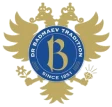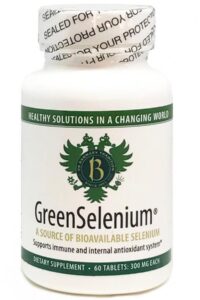GreenSelenium®
GreenSelenium® is a highly bioavailable form of the mineral selenium, which is essential for preventing disease and supporting good health. GreenSelenium® technology provides the first organic selenium manufactured with “green” solvents and with the environmentally friendly process eliminating pollution — which is so important to modern consumers. Free Shipping 60 Tablets
According to the data obtained from the National Institutes of Health (NIH), intake recommendations for selenium and other nutrients are provided in the Dietary Reference Intakes (DRIs) developed by the Food and Nutrition Board (FNB) at the Institute of Medicine of the National Academies (formerly National Academy of Sciences). DRI is the general term for a set of reference values used for planning and assessing nutrient intakes of healthy people. These values, which vary by age and sex, include Recommended Dietary Allowance (RDA) — the average daily level of intake sufficient to meet the nutrient requirements of nearly all (approximately 98%) healthy individuals.
Below are current RDAs for selenium in mcg. For infants from birth to 12 months, the FNB established an average intake (AI) for selenium that is equivalent to the mean intake of selenium in healthy, breastfed infants.
Additional information obtained from the monograph on selenium published by Health Canada on February 9th, 2016 provides the following selenium dose information: Dose information for selenium presented as dose per day, selenium (mcg/day), allows maximum daily intake for adults at 200 mcg/day.
According to a study published in EFSA Journal [2009, 1082; 1-39], the European Food Safety Authority concludes that use of L-selenomethionine as a source for selenium in food supplements would not be of safety concern in adults at dose levels up to 250 mcg/day (corresponding to up to 100 mcg of selenium/day).
The Cancer Council Australia (approved Public Health Committee – May 2006, updated July 2009) issued the following statement: Cancer Council supports the National Health and Medical Research Council recommended dietary intake of 70 mcg/day for men and 60 mcg/day for women with an upper intake limit of 400 mcg/day.
North American selenium status
According to the data obtained from the National Institutes of Health (NIH), selenium intakes and serum concentrations in the United States and Canada vary somewhat by region because of differences in the amounts of selenium in soil and in local foods consumed. For example, concentrations are higher in residents of the Midwestern and Western United States than in the South and Northeast. The extensive transport of food typically allows people living in low-selenium areas to obtain sufficient amounts of selenium. Seafoods and organ meats are the richest food sources of selenium. Other sources include muscle meats, cereals and other grains, and dairy products. The amount of selenium in drinking water is not nutritionally significant in most geographic regions. The major food sources of selenium in the North American diet are breads, grains, meat, poultry, fish, and eggs.
What is the difference between organic and inorganic forms of selenium supplements?
Based on the placebo-controlled study (Burk RF et al.Cancer Epidemiol Biomarkers Prev 2006;15:804-10.), supplementation of selenium supplements to selenium-replete subjects in form of selenomethionine (example of organic form of selenium), sodium selenite (example of inorganic form of selenium), or high-selenium yeast (in which an estimated 75% of selenium was in the form of selenomethionine) was evaluated for 16 weeks. Selenium bioavailability, based on urinary excretion, was greatest for selenomethionine and lowest for sodium selenite. Selenium as selenomethionine was significantly more absorbed and bioavailable in comparison to sodium selenite and high selenium yeast.
Organic and Inorganic Selenium – Bioavailability


